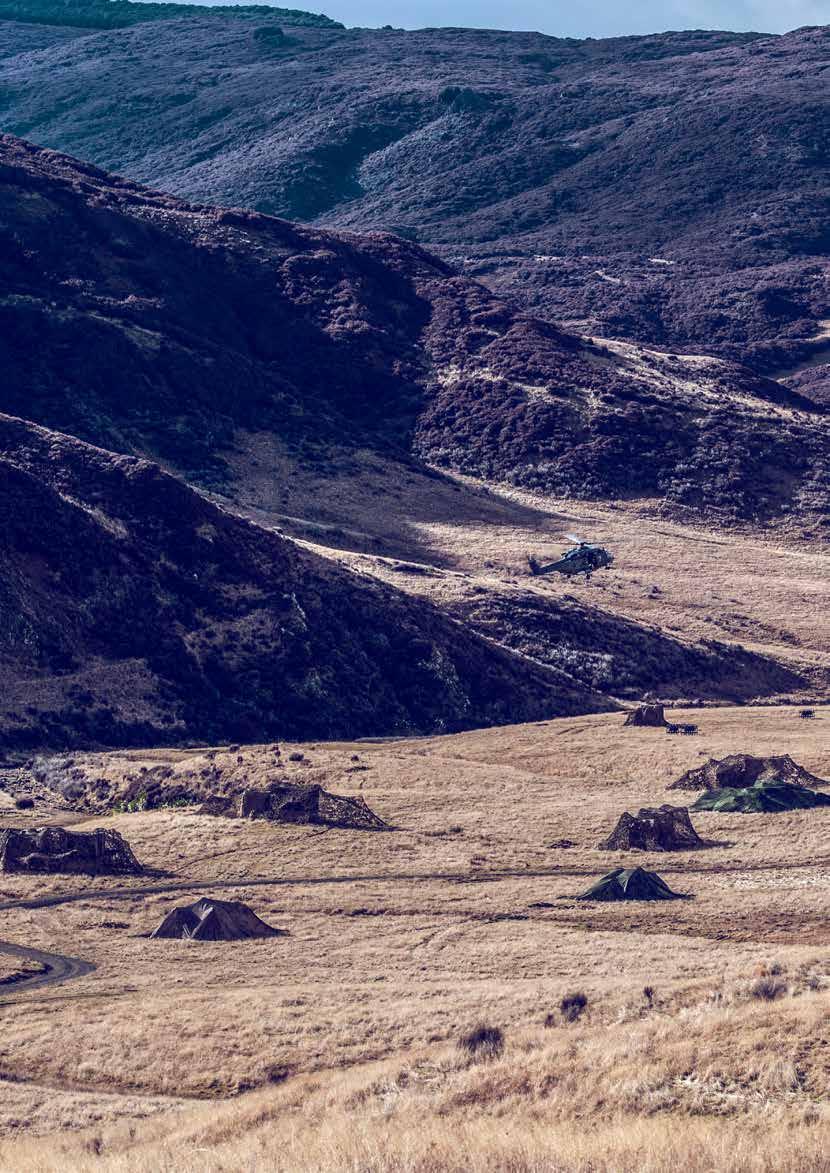
HAPPY 50TH BIRTHDAY 2ND/1ST
EAST TIMOR
25 YEARS ON


HAPPY 50TH BIRTHDAY 2ND/1ST
EAST TIMOR
25 YEARS ON
3
Kia Rite Kia Takatū Ready to Act 4
Happy 50th Birthday 2nd/1st
8 East Timor 25 years on

14 Soldiers tested in tough conditions
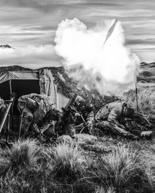
18 Active Edge II
19 A study in Excellence
21 From Regular to Reservist
22 Geophysicist wins Army Innovation Challenge
23 Reserve Force Q&A
24 Specialist combines farming knowledge
26
Evacuating Kiwis from New Caledonia
28 Human performance: Cognitive fitness
29 Book reviews
The Army News is published for the Regular and Territorial Force and civilian staff of the New Zealand Army.
Editor: Judith Martin Ph: 021 240 8578
E: armynews@nzdf.mil.nz
Printing: Bluestar
Private Bag 39996, Wellington
Design: Defence Public Affairs
Editorial contributions and letters are welcomed. They may be sent directly to Army News and do not need to be forwarded through normal command channels. Submit them to The Editor, Army News, DPA, HQ NZDF, Private Bag 39997, Wellington, or by email.
30 Backyard Ultra

33 Giving back during Fiji trip
34 ADF Hockey Association Combined Championship 2024
Deadline instructions: Army News is published on the third Tuesday of each month, except January. Please have all contributions to the editor by the first of the month.
Nothing in the Army News should be taken as overriding any New Zealand Defence Force regulation. Readers should refer to the relevant service publication before acting on any information given in this newspaper. ISSN 1170-4411
© All material is copyright, and permission to reproduce must be sought from the editor. army.mil.nz
Cover: NZ Army’s 161 Battery, 16th Field Regiment gunners conduct fire missions during the School of Artillery’s Exercise Brimstone in the Waiouru Training Area. This exercise assesses students on the Young Officer, Command Systems Sergeant and Weapons Bombardier coursing.
Photo: CPL Naomi James

By COL Ben Bagley Commander, 1 (NZ) Brigade
You don’t have to look far to find credible literature that tells us that the contemporary global security landscape has become increasingly unstable. Major actors are exerting both subtle and not-so subtle influence over smaller entities; threats from climate change or economic downturn are providing opportunities for malign elements to establish a foothold; we find ourselves in a period of competition where even our deployment on exercises is being scrutinised and analysed by our adversaries and those of our partners. The persistent campaigns and operations of the last three decades have reduced significantly, but the need for readily deployable Land Forces has not. Some have questioned if our purpose has changed as a result, and the simple answer is No. Our purpose within the 1st (NZ) Brigade remains –Ready to deploy resilient individuals and teams, into austere environments, to prosecute operations at reduced notice. It is articulated this way for a reason; because we know that in our close region we will likely have to execute our business at reduced notice with the capabilities and equipment we have available right now. It is a challenge at times, but it is vital that we maintain a culture of readiness in order to react in the manner that is expected of us.
The Brigade has worked hard following our exit from Op Protect to re-train ourselves and regain our tactical proficiency; but we still have some more mahi to do. We are well positioned to take that next step in tactical complexity in a Battle Group centric, Combined Arms environment. We will test that proficiency on Ex Talisman Sabre 2025, integrated with the Australian Army’s 7th Brigade – our sister Brigade under PLAN ANZAC.
The range of operations and environments hasn’t changed either; however we have refocussed our primary AO back to our region, encompassing the Indo-Pacific. To provide military response options to our government we still need to be proficient at both mid-intensity Joint Land Combat, and the full suite of Stability and Support Operations. Our ability to deploy a Battle Group in our region, in concert with our regional partners, accounting for the changes in warfare observed in other current conflicts will be key.
Now is our time to prepare ourselves for such a scenario, especially given the relatively recent three year hiatus in training. Now is the time where we prepare the greatest capability we have in our arsenal – that being our people. The opportunities to participate
Now is the time where we prepare the greatest capability we have in our arsenal – that being our people.
– COL Ben Bagley
in multinational exercises are only increasing as we continually look to enhance our interoperability with our regional partners. Deployments also continue to be explored by our higher headquarters with a view to providing a range of opportunities for development, experience and growth. Make sure you are ready to seize these opportunities when they present themselves – square away your mental and physical health, maintain your deployability, and look after your mates, family and whānau.
Looking forward your personal mission remains simple: Be the best at what you do – within your role, as a professional soldier, as a warrior of Ngāti Tūmatauenga Kia Rite Kia Takatū – Ready to Act
By WO1 Wiremu Moffitt
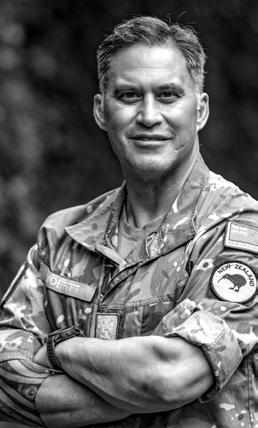
Like any good thing, everything comes to an end.
This is my final article as the 16th SMA, a tenure and role I relished over the past four years. There’s nothing more fulfilling than having purpose and great meaning to your life – this has been the case for me. While our career does not define us, specific roles within our Army are a deeper mixture of military tasks, appointment responsibility and care of people. Whilst I enjoyed the time and experiences of Office of SMA – it did not come without a few challenges. Preparing a Force for crisis and conflict can be tough enough, but throwing in global epidemics, a national lock-down, some weather events, and sustained deployed-operations across the world –and we really have had our work cut out. But isn’t that what soldiers do? Being there for our Government and New Zealanders when they call for help. Like you, I joined to serve – both domestically and abroad. Leading as SMA alongside Chief of Army Boswell has been a real privilege, and few things will top that in a military career.
I have left the role to take up the 5th Warrant Officer of the Defence Force, a job that supports not only the CDF, but all Services and portfolios of NZDF. One of the things I relished most about Army was engaging with you – our soldiers and officers of the Land, Joint and Special Forces. I look forward to continuing this at the next level across our force.
In the coming months, you’ll see several command appointment changes. Remember militaries run on subordinate-commands, so rather than worry – use the opportunity to run with a few less bosses around. Likewise, the next SMA will not be selected for a while. WO1 Andrew “Mus” Boykett will stand-in for the role, and I know he will do an outstanding job.
Although this is late, thank you for the opportunity to be your SMA. Thank you for the commitment you make, for the jobs you do, and the great service and sacrifice your families give for New Zealand.

By Laura Jarvis
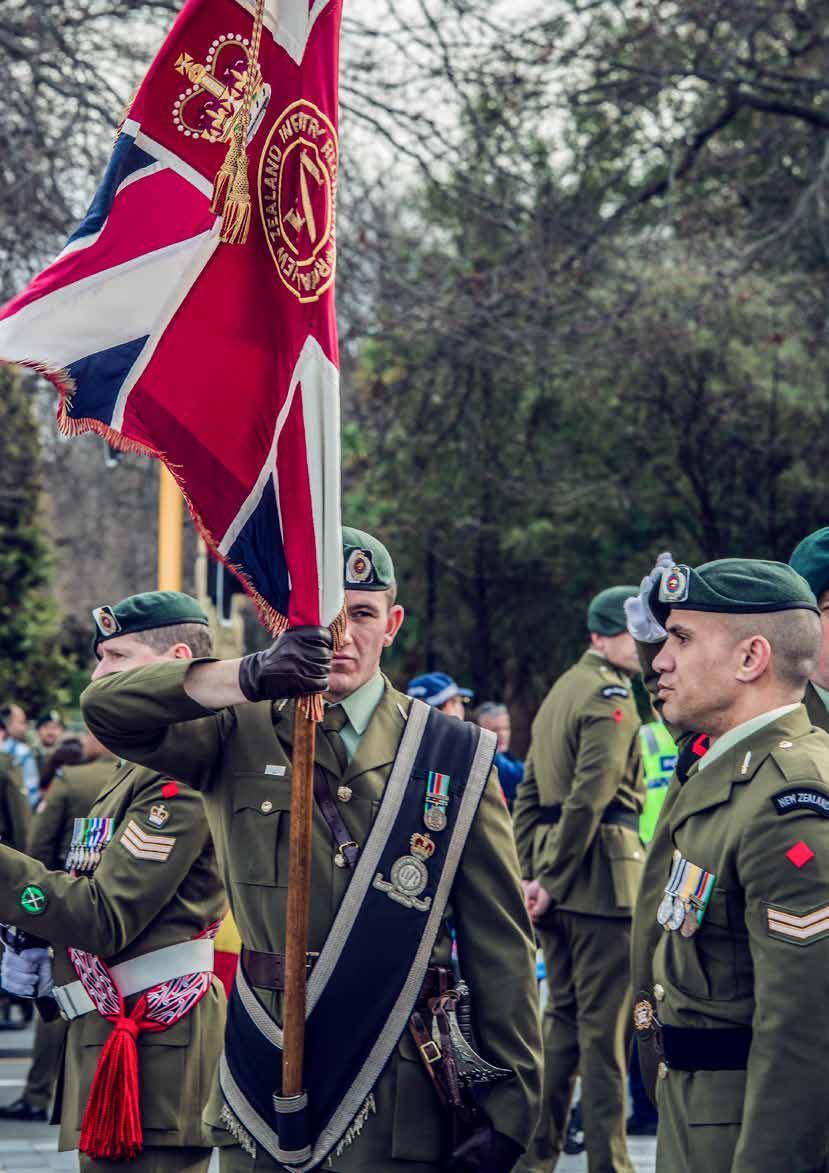
A parade through Christchurch’s central city, a 25 year old time capsule, and the reuniting of veterans were all highlights for the New Zealand Army 2nd/1st Battalion RNZIR as the unit celebrated its 50th anniversary earlier this month.
Royal NZ Infantry Regiment marched through the streets
Image bottom: Past members, friends, and family were welcomed into Burnham Military Camp to experience the Army culture within 2nd/1st Battallion.
A charter parade as the celebrations began drew large crowds as 250 soldiers marched with swords, weapons, and regimental colours, joined by the Army Band, and unit veterans.
Stopping in Cathedral Square, Mayor Phil Mauger inspected the parade before reading the historical charter document, acknowledging the unwavering support of the city through difficult times.
The parade then continued through the streets, passing iconic Christchurch landmarks like the Bridge of Remembrance. Former battalion members were then ‘welcomed home’ on Saturday to Burnham Military Camp with a powhiri.
Part of this group was Major General (Rtd) Ken Gordon, who was the Commanding Officer of 2nd/1st Battalion from 1976–78, shortly after the battalion was formed.
Having already held other commanding officer positions, he never thought he would get a chance at the role, which turned out to be a highlight of his career. Standing on the familiar parade ground, Major General (Rtd) Gordon, who joined when he was 18 was faced with soldiers who are now at the beginning of their careers.
“I looked at the young soldiers and thought, they are around 70 years younger than me. I was there 70 years ago; it’s hard to imagine that.” he said.
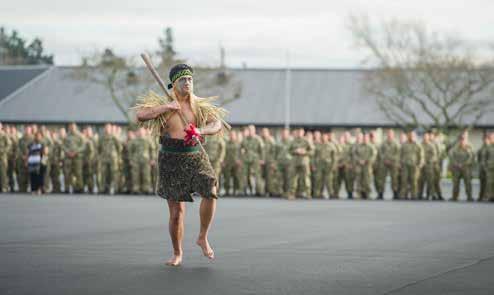
The day was filled with ceremonial drill including a feu de joie ceremony along with interactive displays to show modern capabilities. For Major General (Rtd) Gordon, who left service in 1987, this was a standout moment.
“When I look now at a soldier, I can’t imagine what he has got on him – all the bells and whistles. If anything, what I saw that was different, was the way a soldier is kitted out. We were really just the dog end of the war when I joined but everything has changed,” he said.
A 25 year old time capsule was then lifted, showing a snapshot in time of the battalion including photos and kit. This was replaced with a new capsule, to be lifted in 25 years. The current Commanding Officer, Lieutenant Colonel Sam Smith, said every unit member who has served has made their own unique contribution to the history of 2nd/1st Battalion.
“While the Battalion may look very different from the one formed fifty years ago, some things have not changed. The quality and calibre of the soldiers who form the sections, platoons and companies of the battalion and the way the unit has just got on with the job of soldiering is the same now as they have always been.”
“Throughout these years thousands of New Zealanders from the Battalion have served in New Zealand and deployed on operational service in Bosnia, East Timor, Afghanistan, Solomon’s Islands and Iraq, to name but a few.”
The Battalion was formed on July 1, 1974 after a decision was made that a second Regular Force battalion was to be formed, based on the existing 1st Battalion Depot, which became the 2nd/1st Battalion, Royal New Zealand Infantry Regiment (RNZIR).
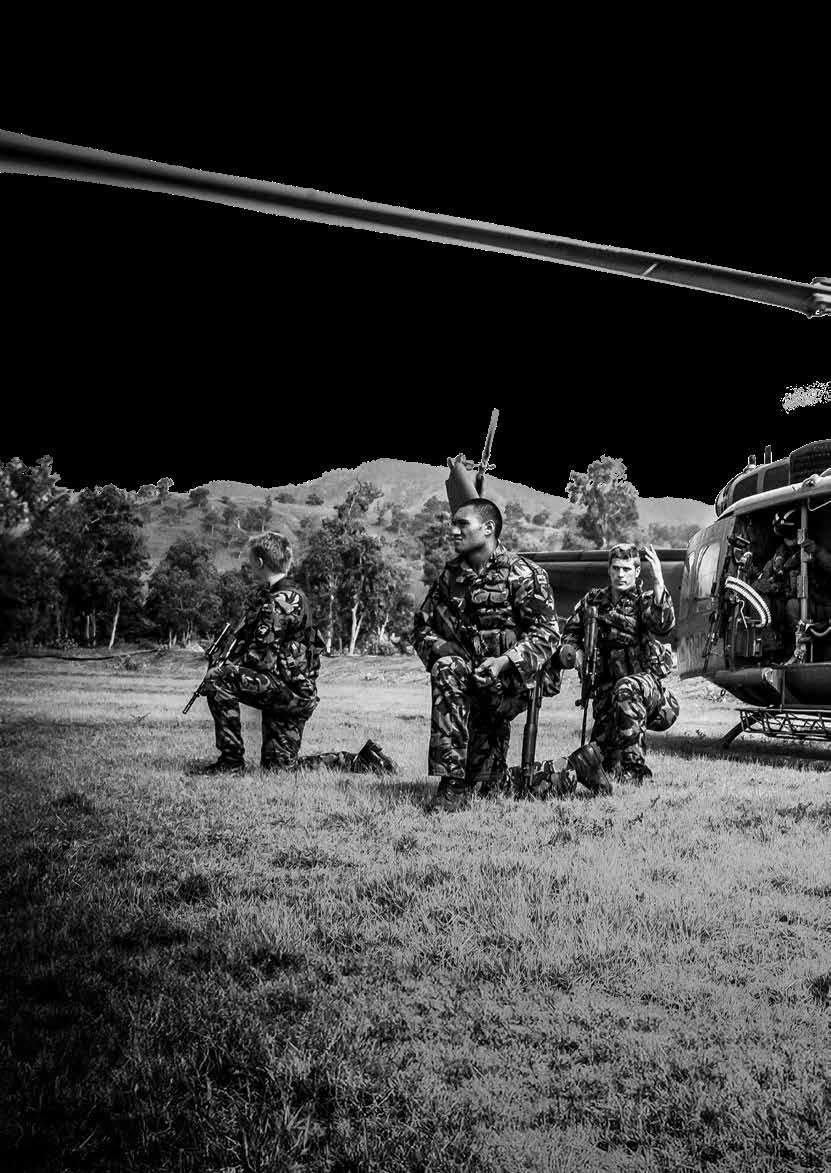

25 YEARS ON
Following East Timor’s pro-independence referendum in the late 1990s vengeful militia murdered and raped, and systematically burned every city and village in their wake. Hundreds of thousands of East Timorese fled to escape their tormentors. In an effort to make, and then keep the peace, New Zealand sent more than 1000 soldiers, aviators and sailors to the island in what was this country’s largest deployment since Malaya in 1957.
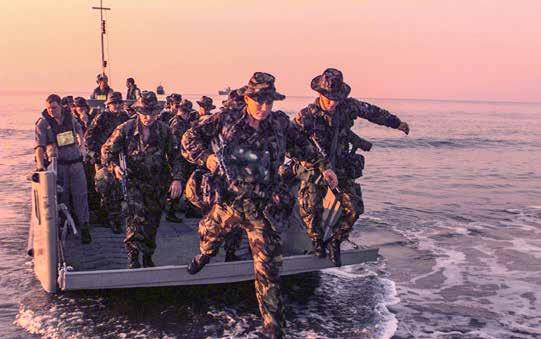

Twenty-five years ago the New Zealand Army was preparing for one of its most significant deployments – East Timor. It was a deployment that would last, in differing ways, for some 13 years.
Lieutenant Colonel Peter Wood was the commanding officer of what was known as NZBATT4. It was, he says, a privilege to command an infantry battalion on operations.
The decision to mount a fourth New Zealand rotation was only announced, unexpectedly from my perspective, a few days after taking command of 1 RNZIR in December 2000.
The 660 New Zealand members of NZBATT4, a battalion group based around 1 RNZIR and which would eventually have an all-up strength of some 900 All Ranks if contributing national contingents were included, formed in March 2001. We were only permitted 60 days to complete our OLOC training and integrate logisticians, signallers, suppliers, medical staff and a host other combat, combat support and CSS trades and elements from a range of contributing units, including 60 members of the Territorial Force. Despite this time constraint, it worked.
We deployed in May 2001. On taking over from LTCOL Dave Gawn and NZBATT3, we assumed command of the Irish Platoon and Fijian and Nepalese companies already in country. A Singaporean platoon soon joined us. It was a bonus to have this contingent from one of our affiliated units, the SAF Commandos.
The focus of our deployment was on maintaining security within our area of operations which bordered Indonesia. We sustained this during the Timor elections and large-scale repatriations of displaced Timorese from across the border with Indonesia.
A few reflections on the deployment some 23 years later are that:
• Our OLOC training was enhanced by detailed reporting from CO NZBATT2 on the contacts his unit had during their deployment and the lessons they gleaned from those incidents. This was augmented by a comprehensive Land Command training needs evaluation team report written during NZBATT2’s time, pre-deployment information shared by NZBATT3 whom we would replace, and through the combined experience of the 200 members of 1 RNZIR now in NZBATT4 who had returned from their INTERFET deployment just 12 months prior. All of this ensured our training was realistic and relevant.
• Our proficiency was enhanced through deliberate focus from our arrival on area (re-) familiarisation and ‘ako’, or learning. This lasted for the first four weeks, so it was time bound. While undertaking ‘business as usual’ we also rehearsed and tested ourselves using systems and standard operating procedures such as reaction to militia sightings, deployment of the Fly Away Team and activation of reserves. From these, we made slight improvements to our internal boundaries and adjusted our internal boundaries slightly. We were now ready to dominate the border area, support elections and facilitate repatriations, confident that procedures to report, support and react to a range of contingencies were in place and would function.
• During the election period we needed to create an additional rapidly deployable but scalable reaction force. To achieve this LOG COY was re-roled for security of the BN FOB and APOD to free up Fiji Coy and Spt Coy for ops, validating our PDT and reinforcing that all members of the unit, irrespective of corps, trade or rank, needed to be soldiers first and foremost.
• The unit received significant support from the 3 Squadron helicopter detachment based at the APOD in Suai. This re-established the previous close relationship from Singapore days when members of 1 RNZIR and the NZ Force Southeast Asia helicopter detachment from 3 Squadron RNZAF lived together in Dieppe Barracks and flew from the adjoining SAF airbase to support our jungle training. This demonstrated the high levels of cooperation and understanding that can be achieved through frequent interaction and liaison. They probably flew those same helicopters in Timor!
• Although the infantry skill levels displayed in Timor were high, a real corporal and lieutenant level deployment, it was evident on return to NZ that we had all lost our edge in conventional skills and operations. This illustrates how perishable these core individual and collective skills are, and significant responsibility we place in our most junior leaders. We need to continue to invest time and resources in these areas despite the inevitable distractions.
• I judge our deployment to have been a success, even if we did not experience the contacts, casualties and threat levels experienced by the first two rotations. Success cannot be attributed to any one person or group. Whether a rifleman, medic, signaller or cook, all individuals in the unit irrespective of rank or role contributed, in their own way, to our collective success and can be equally proud of the part they played. ONWARD.
By Dr Andrew Macdonald
Twenty-five years after the New Zealand Army first set boots on the ground in Timor-Leste, Te Aroha veteran Evan Williams is set to re-trace the footsteps of his men in a journey of personal pilgrimage.

“It will be a great opportunity to share and reflect my feelings and to see the progress made since 2000,” said Major General Williams, who has long anticipated his firstever return to Timor Leste.
“I have often wondered what TimorLeste looks like now,” he pondered, noting the island nation also experienced security issues in 2006–08.
‘I will be able to see the progress and to reflect on the results of our [i.e., NZ Defence Force’s] efforts.’
Back in 2000, MAJGEN Williams was a 33-year-old Major, commanding B Company of Batt 2, which was drawn from the Burnham-based 2nd/1st Battalion of the Royal New Zealand Infantry Regiment.
Batt 2 was the second rotation of Kiwi infantry to what was then East Timor, a tropical nation about 500km north of Australia. The first rotation was known as Batt 1, and deployed in 1999. MAJGEN Williams is returning to Timor-Leste in the second half of July with the Back to Timor group, a veteran-led tour of the places, outposts, villages, jungles and roads that he and his men knew well.
The southeast Asian nation occupying half the island of Timor was plunged into violence in 1999 when a referendum supported a breakaway from Indonesia. Overall, about 1400 civilians were killed, an unknown number tortured, and women were raped and subjected to other forms of sexual violence. Some 500,000 people were displaced.
Between 1999 and 2002, NZDF deployed over 5000 personnel there as part of the International Force East Timor (Interfet), a non-UN peace-making task force to address the unfolding security and humanitarian crisis.
Now, MAJGEN Williams has just retired as one of the army’s most-senior officers. His total service an ace shy of 40 years in a career that has spanned Belize, Bosnia, Sinai, East Timor, Banda Aceh and Afghanistan.
His father, the late Colonel Lindsay Williams, had 33 years’ service in the army, too. Both men were infanteers. Williams the senior was a decorated, highly regarded company commander in Vietnam. Against this fabric, MAJGEN Williams recalled his pride as a young officer selected to command an infantry company in East Timor, in the municipality of Cova Lima on the southwest coast.
A country and people in need of security, who have suffered a lot at the hands of brutal and inhumane militias.
– MAJGEN Evan Williams
“It was a realisation of the ultimate purpose – to deploy operationally commanding NZ soldiers,” said MAJGEN Williams, a 57-year-old widower who is both a father and grandfather.
On arriving in East Timor in 2000, he found a “country and people in need of security, who have suffered a lot at the hands of brutal and inhumane militias.”
The West Timor militia’s massacres –such as at Suai Cathedral, where 200 locals were murdered – were well known, and the macabre locations of these crimes were constant reminder to Kiwi soldiers of the environment in which they were operating.
MAJGEN Williams continued: “The standard of living in [then] East Timor was incredibly basic but the people were friendly and caring. We made sure we returned this in kind.”
For the first 27 days in-country, it rained non-stop, causing huge logistical issues as roads and tracks washed out.
Thereafter it was hot and humid. Then, of course, there were risks. Beyond the snakes and scorpions and malariacarrying mosquitos, there were large parties of armed West Timor militia that infiltrated the border into East Timor.
“We managed our operations as if we were in a high-risk combat zone!”
That meant discrete observation posts and armed Kiwi patrols criss-crossing the rugged, bush-clad island terrain, which comprised a spine of mountains that yielded to braided-river plains.
During one such patrol on a hill known as Foho Debeluik (‘Feature 799’), 24-year-old Private Leonard Manning was killed in action in a pro-Indonesian militia ambush. His body was mutilated. That was on 24 July 2000. “The events leading up to and following the death of Len are crystal clear and I remember them often,” said MAJGEN Williams. Private Manning’s body was returned to New Zealand and buried at Rangiriri Cemetery in Waikato. Over the years, many of his comrades have stopped by, including MAJGEN Williams. He added that Private Manning’s death served to galvanise Batt 2’s resolve in providing the people of Cova Lima with a secure and stable life.
In May 2002, East Timor moved to shrug off its past when it became the first new sovereign state of the new century, the Democratic Republic of Timor-Leste. All of that will be front of mind as MAJGEN Williams – alongside other Batt 2 veterans – treks solemnly through the glades and up the glacis slope of Foho Debeluik, to a certain lonely spot. He last stood there, just on dusk, in a scene full of pathos, 24 years ago.
“It provides me a chance for closure,” he said.


By Jo Priestley
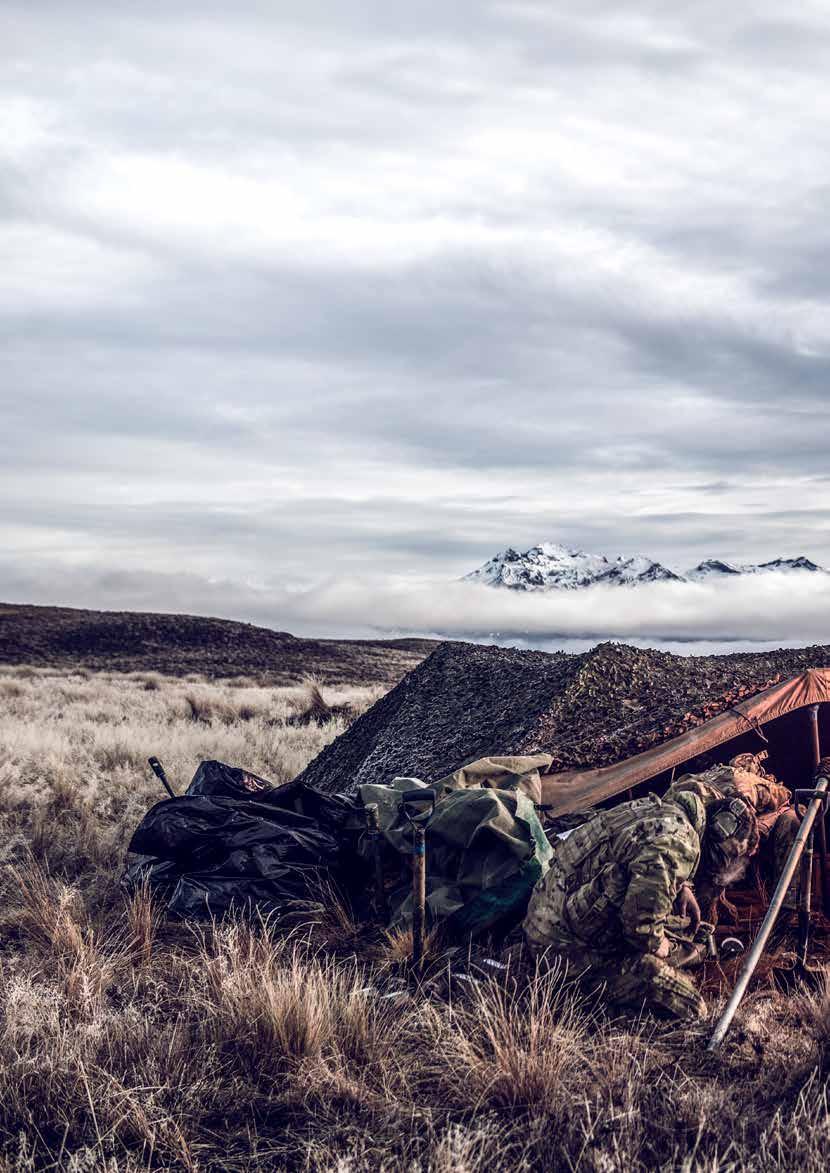

More than 300 soldiers from 1st (NZ) Brigade and the Training and Doctrine Group battled biting winds and below freezing temperatures across a series of live field firing and battle handling exercises at Waiouru Military Training Area.
We need to be combat ready and able to move at short notice if the New Zealand Government calls on us to assist.
– MAJ Haedyn Jenkinson
Exercise Vengeance 2 – a Victor Company, 1st Battalion, Royal New Zealand Infantry Regiment (1 RNZIR) exercise – enabled its soldiers train in close country environmental conditions.
Major Oliver Lynn, Chief Instructor School of Artillery, said the second exercise, Brimstone, was the culminating exercise for three School of Artillery courses – the Young Officers Course, Command Systems Sergeants Course and the Weapons Bombardier Course –where students were able to put theory into practice under live firing, field conditions within a tactical scenario.
The exercise was supported by 161 Battery, 16th Field Regiment, and saw the deployment of most elements of the Artillery ‘system’, including NZLAV mounted observers, armourers and logistical support, as well as the recently acquired Vector Scorpion uncrewed aerial system.
The third and final training scenario was Exercise Active Edge 2, a 2nd Combat Service Support Battalion exercise designed to test the deployment of a Combat Service Support Team (CSST).
The CSST provided logistics support to both Exercises Brimstone and Vengeance 2, with transport, ammunition and, most importantly, food to the hundreds of cold, wet and hungry soldiers.
The exercises provided a valuable opportunity for soldiers to put theory into practice in a combined arms combat environment, and also enabled different parts of the Army to work together, generate training efficiencies, and see how well different units integrated.
The opportunity to work with NH90 helicopters from the RNZAF’s No. 3 Squadron was an added bonus – an air mobile operation, where the 105mm Light Gun was underslung and transported to a new location, and an Air Observation Post was conducted. This saw the Joint Fires Team fly tactically, whilst conducting live calls for fire missions.
Run over two weeks, students were tested on their use and employment of the 81mm mortar, before moving on to the 105mm light gun.
“The exercise, and qualifications the students will acquire represent a major step up for our junior leaders who moved from being an operator within the system, to tactically commanding and leading their respective capabilities, and in some cases commanding their peers,” Major Lynn said.
Ten kilometres away, Ex Vengeance 2 saw Victory Company, 1 RNZIR, carrying out its own training and evaluation of its soldiers in close combat conditions.
The exercise included a complex set of tasks which incorporated aircraft, infantry, surveillance and reconnaissance, snipers, direct fire machine gun sections, signals, medics, intelligence operators and logistics personnel.
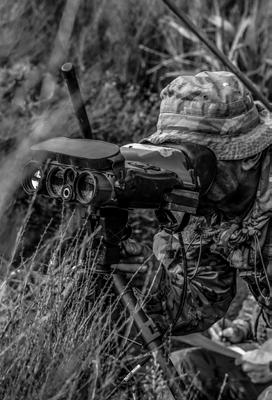
Major Haedyn Jenkinson, Officer Commanding Victor Company, said the terrain in Waiouru is great to train in as it mirrors the different types of challenging environments they can expect to see on actual overseas operations.
“We need to be combat ready and able to move at short notice if the New Zealand Government calls on us to assist. It could be combat, or it could be to provide assistance after a cyclone or natural disaster,” Major Jenkinson said.
“Whatever the mission may be, we need to ensure our training prepares us for the vast number of situations and scenarios we may find ourselves in.”
Major Jenkinson said Ex Vengeance 2 built on earlier exercises which tested soldiers’ collective skills such as patrolling, ambushing, and both quick and deliberate attacks onto enemy positions in a close country environment.
Around 40,000 rounds of rifle and machine gun ammunition was used over the two weeks.
“This type of exercise provides invaluable training for our leaders as well as ensuring our interoperability with other units in a combined arms setting,”
Major Jenkinson said.

close country assault with fire support.
An integral part of Exercise Brimstone was the relaying of information from a vantage point in the battlefield back to the battery via an Observation Post (OP).
Called the “eyes and ears” of the artillery, the OP uses high tech equipment to locate the enemy and relay accurate target information back to the NZ Army battery for engagement.
Captain Matthew Ripley, 163 Battery 16th Field Regiment, RNZA, Joint Fires Team Commander, is an experienced Forward Observer.
He said one of their tasks was to avoid being seen by the enemy as they presented a very “tasty target” to enemy forces as they are at the sharp end of battle.
“Second to taking out our guns is the enemy taking out the forward observation post and the intelligence we provide to our battery,” said Capt Ripley.
“We calculate distances using equipment, maths and trigonometry so our battery can adjust its fire to land more accurately on an enemy target. We speak directly to the battery itself so information gets there quickly and reliably.”
The Forward Observation Post works with RNZAF helicopters by flying with them and providing a mobile observation post, increasing the flexibility and lethality of the artillery.
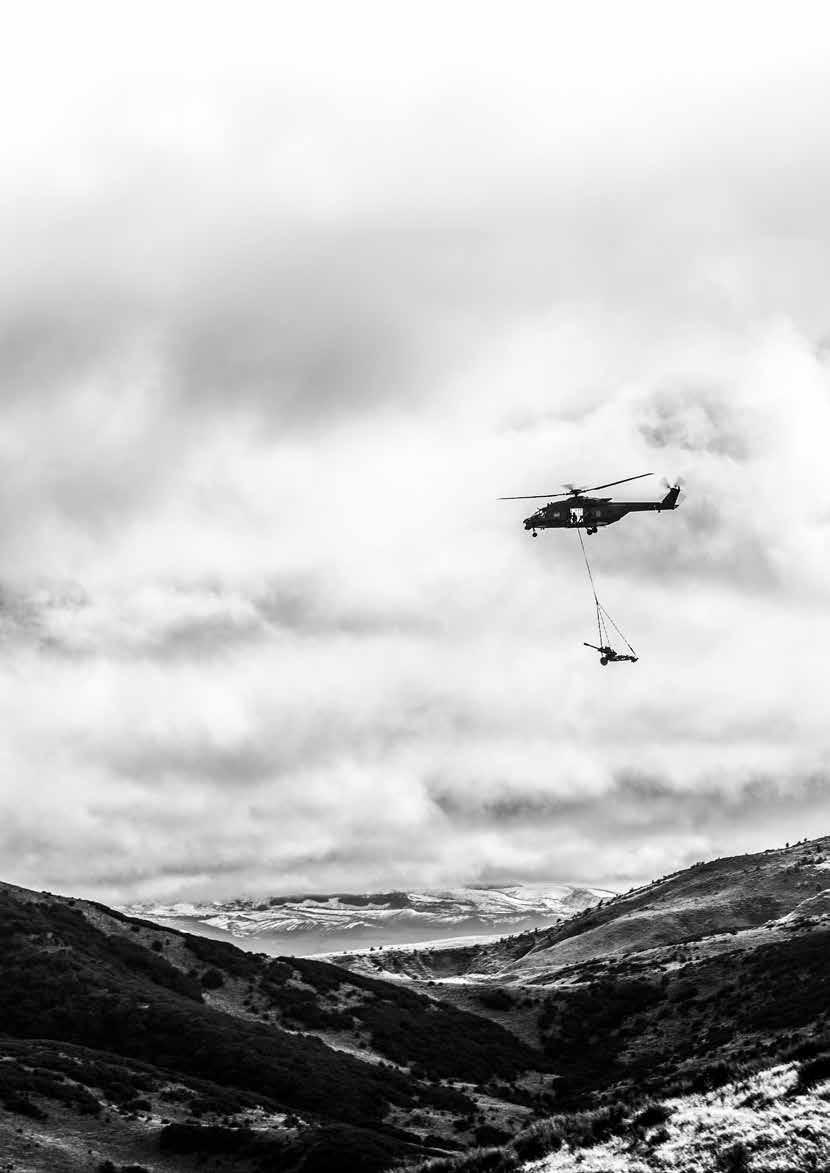
A Combat Service Support Team (CSST) tested and evaluated its ability to provide real time logistics support to two separate exercises held simultaneously at Waiouru Military Training Area recently.
The aim of Active Edge 2 was twofold – to plan and deliver logistics functions support to Exercise Brimstone and Exercise Vengeance 2; and to practice soldiers on weapons systems, night vision and communications equipment to operate at night and defend against various threats while providing that support.
The CSST from 2nd Combat Service Support Battalion (CSSB) represented eight of the 11 different trades with the Royal NZ Army Logistic Regiment (RNZALR) and provided ammunition, food, water, transport, repair, movements and other mission essential military equipment to both exercises. It challenged its movement operators, logistics specialists, combat drivers, maintenance support and ammunition technicians to provide and demonstrate specialist trade skills while maintaining a combat focus and awareness of an adaptive, aggressive and free-thinking adversary.
XO 2nd Combat Service Support Battalion, Major Timothy Cocks, said logistics are the backbone of military operations and are critical to ensuring the NZ Army remains combat effective and ready.
“Without RNZALR personnel, essential supplies and ammunition would not make it to the troops in order to allow them to fight, hot meals would not be provided, equipment couldn’t be repaired – affecting mission essential equipment like night vision, radios and weapons. This would lead to stocks quickly being exhausted.”
MAJ Cocks said the CSST rose to the challenge in an austere environment.
The CSST recovered and repaired broken vehicles, conducted fabrication in the field in order to repair items; conducted counter vehicle ambush drills to improve CSS survivability, and sustained the force through land and air deliveries.
Exercise Active Edge 2 is a 2
CSSB Logistics Training Exercise that took place in the Waiouru Military Training Area providing support and assistance to Exercise Brimstone and Exercise Vengeance. The exercise evaluated the Combat Service Support Team in the ability to plan and execute small team tasks to deliver a logistics function.
Photo: CPL Maddy Butcher
The Human Performance Cell (HPC) run by the NZDF out of Trentham is gaining international attention for its scientific approach to optimising soldier readiness. The HPC is led by Major (Dr) Jacques Rousseau who says he’s been approached by our military partners who want to be a part of the Defence Force’s soldier readiness, resilience and performance programme.
MAJ Rousseau says their success stems from being in uniform and embedding with units during programmes and projects –monitoring, analysing, researching and applying innovative practices. He said having a uniformed HPC is unique to the NZDF and is the envy of military partners observing HPC projects.
MAJ Rousseau says his role as Officer in Charge of HPC is multi-faceted and involves the overall effectiveness and readiness of military personnel, maximising the amount of personnel ready for deployment at any given time. “I conduct and manage the HPC’s applied research (mostly field based) and development programme to advance the understanding of human performance in military settings and explore innovative strategies for optimising soldier readiness, resilience, and performance. This includes collaborating with scientists at DST (Defence Science and Technology), researchers, and practitioners from various disciplines to develop evidencebased programmes and practices.
By Jo Priestley

“The HPC assists our physical training instructors with physical conditioning design and implementation and monitoring of evidence-based physical training programmes tailored to the specific needs of military personnel. In addition, we also work to prevent injuries through biomechanical assessments to provide suitable training techniques and injury prevention strategies.”
MAJ Rousseau is researching a variety of factors that impact a soldier’s performance including nutrition, lack of sleep and recovery to military performance, shoulder injury and load carriage, physiological and cognitive monitoring of cadets, to name just a few.
In his home country South Africa MAJ Rousseau was Commanding Officer of the Human Performance Unit Gauteng Medical Command, managing and directing the regional and service headquarters (Army, Navy and Air Force) human performance programmes, which included physical training and rehabilitation. On arrival in New Zealand in 1999 he accepted a lecturing position at Massey University.
“My role was to develop and manage the Diploma in Exercise Science. During this time I completed a Master’s degree in Sport and Exercise Science, and founded, implemented and managed the Massey University (Wellington) Clinical Exercise programme.”
In 2011 the NZDF learnt of his extensive military experience as a human performance specialist (exercise physiologist). As a result of this MAJ Rousseau was recruited to look at developing a human performance programme within the NZ Army.
“I was offered the opportunity to return to uniform which I was happy to accept,” said MAJ Rousseau.
“My work is about keeping our people healthy and resilient both physically and cognitively throughout their military careers. It is about being looked after and valued by the organisation – they deserve the best support possible.”
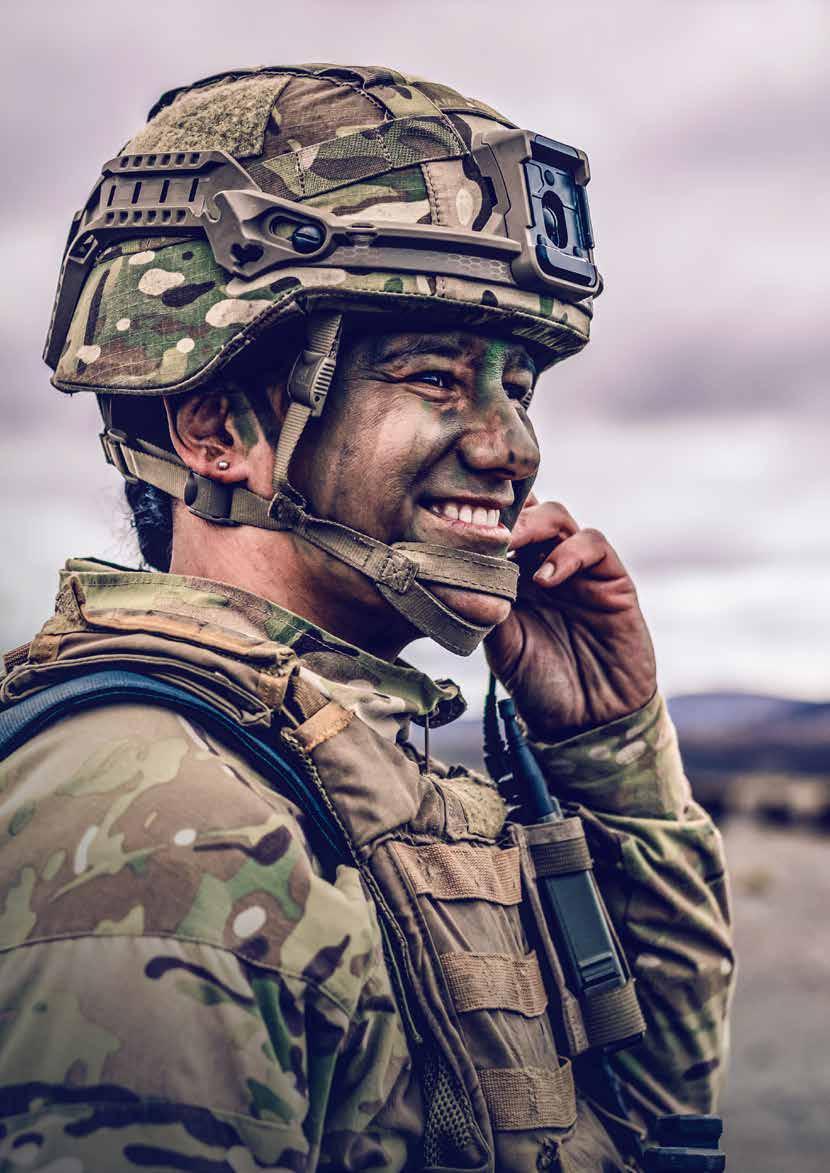
By SGT Caroline Williams
Transferring from the Regular Force to the Reserve Force was as easy as ticking a box and waiting to be notified, says Combat Driver, Corporal Cindy Ries-Rupapera, now serving with 38 Combat Services Support Company (38CSS Coy).
“This is my third training weekend I’ve attended since my transfer, and I’ve also taken driver training for some of our Reserve Force soldiers heading on deployment.
“Since leaving I retrained in the construction industry, attending a year long course at UCOL. While I was training at UCOL, I was a contract driver instructor for Te Tihi o Ruahine Whānau Ora Alliance, and am now employed by building contractor L.T McGuinness Limited. I’m no longer doing the driver training this year as I’m fully employed by L.T McGuinness.”
As a driver instructor to Te Tihi o Ruahine Whānau Ora Alliance, Corporal RiesRuapapera helped people gain their vehicle license to assist in employment opportunities. Although predominantly focused around Māori and Pacifica, Corporal Ries-Rupapera says any one is welcome to come and upskill to achieve job placements.
“The Army taught me how to teach people new skills and to adapt to working with a wide variety of personality types to complete a task. That training really helped with my driver training at Te Tihi o Ruahine Whānau Ora Alliance,” she says.
“Staying current in the Reserve Force has also helped my civilian work as it keeps my license grading up to date.”
Joining the Reserve Force has meant Corporal Ries-Rupapera can continue her sporting passion for competitive rugby of which she is a New Zealand Army Rugby representative.
Late last year she had the opportunity to catch up with old mates and utilise her Army skills during a joint training exercise that involved both the Reserve Force and Regular Force.
Corporal Ries-Rupapera was the transport section commander for the weekend phase of the exercise which involves commanding a vehicle packet of up to eight vehicles and 16 soldiers, and coordinating protection of the convoy.
“As a combat driver we are responsible for keeping ourselves, vehicles and stores safe. If we come under contact on a vehicle move we need to know how to protect ourselves and move together while getting out of that situation. We do not move forward into contact, we move back to a known safe location while the mounted gun vehicles provide cover.”
She also gave lessons on the use of the MAG 58 gun and the vehicle turret where the gun is mounted.

“It’s been awesome seeing old friends again, it keeps me in contact too. The Reserve Force training isn’t as intense as when I served in the Regular Force but we get hands on tools. Only serving in a weekend means we have limited training time so we need to focus on particular skills, and it’s also recognised we need to be at our civilian jobs too,” she says.
“I’m really pleased I transferred over to the Reserve Force, it’s been great keeping up with my skill set, catching up with old mates, and making new ones in the Reserve Force.”
Any Defence Recruiting enquiries can be directed to 0800 1 FORCE. Each Reserve Force company has its own training programme in line with its battalion’s training focus. Company level training typically occurs one weekend a month with platoon level training occurring one night a week.
By SGT Caroline Williams

Winning the Army Innovation Challenge 2023, Future Sight Category, announced earlier this year, has been a highlight in Sergeant Rick Henderson’s Army Reserve Force career. With twenty five years clocked up as a geophysicist in the oil and gas industry, including international experience and running his own consultancy, he’s found a way to incorporate his civilian profession into the NZ Army.
His entry, selected from 35 submissions, provided background and justification to assess geophysical remote sensing techniques for the detection of unexploded ordnance (UXO), land mines, improvised explosive devices (IEDs) and other explosive and pyrotechnic hazards (EPH) utilising an unmanned aerial vehicle (UAV) and geophysical tools for detection.
Acting Deputy Chief of Army, Colonel Mike van Welie, spoke of the importance of innovation for the future of the Army.
“Thank you for putting effort into your submission. We need to focus on our people then our mission, and your project has focused on people. We need to protect innovation as it is always focused on improvement, and comes from a good place.”
COL van Welie recalled time he spent on deployment in Afghanistan where a soldier found numerous IED’s, and how SGT Henderson’s development could have made things much simpler and safer for the soldier.
SGT Henderson explains, “Cluster munitions and land mines pose significant hazards to civilians and any future peacekeeping operations in affected countries (e.g. Ukraine, Syria). Development of a capability to quickly and safely locate EPH would be beneficial for both tactical and humanitarian purposes.”
Worldwide, explosive remnants of war (ERW) are categorised as a critical humanitarian concern. They can restrict social and economic development making innovations like Sergeant Henderson’s extremely significant. SGT Henderson also notes that areas closer to home such as the Pacific and NZ itself, could benefit from the innovation.
We need to protect innovation as it is always focused on improvement, and comes from a good place.
– COL Mike van Welie
“In the Pacific area, such as the Solomon Islands and Papua New Guinea, significant quantities of EPH remnant from World War II exist, and here at home we have blinds and other hazards scattered throughout our training areas. Locating items using remote methods could potentially save lives, and a quick remote detection capability could also minimise downtime when blinds occur during Live Field Firing activities. Potentially, the technology proposed could also be used in natural disasters where buried infrastructure or other items need to be located.”
The pre-judging panel consisted of six senior commanders across Army, including Defence Excellence, the Army Innovation and Experimentation Managers. Finalists were required to put together a 10 minute video presentation followed by another round of judging. Sergeant Henderson’s award consists of a special taonga (guardian necklace), certificate and innovation challenge coin, of which only eight have been issued, and he was also presented the Deputy Chief of Army challenge coin.
By WO1 Timothy Sincock
In the Reserve Force, Sapper Tetyana Sanders is part of 4 Troop, 2 Field Squadron, 2 Engineer Regiment (2ER). In her civilian role, Sapper Sanders is an Army Lessons Officer in the newly formed G7 Army Training Branch.
The Army Leadership Board approved AE24 to be conducted over the period Apr 24 – Aug 25. The purpose of the experiment is to ensure that leaders can apply limited resources to address the priorities of modernisation, personnel, and readiness. The experiment will test hypotheses and research questions under controlled conditions to explore warfighting concepts, technologies and conditions. The experiment will focus on the readiness and responsiveness of the force. This will create a baseline of knowledge to understand new concepts, formations and technologies that could be employed in the future. The baseline of knowledge will also be used to facilitate decision making.
AE24 is important to Army. It will potentially shape Army for the future (including where the ResF fits in and contributes).
In 2020 Army conducted a trial of what was known as the Army Comms App (ACA). The ACA was an adaptation for the Army ResF of an app developed by an external company and successfully used by a government department.
The purpose of the trial was to prove the value of the ACA to bridge the gap between ResF personnel and the NZDF digital environment.
Trial results suggested that the ACA met the user requirements of the ResF and was aligned to the Army25 Information Theme: Improved Digital Workplace. The Army Management Board supported implementation of the ACA, pending funding. In the meantime, it was hibernated by the vendor, at an annual cost to Army.
However, due to financial constraints, Army has not been able to fund the ACA for the last two financial years and will not be able to fund it in the 24/25 FY.
The four years of hibernation of the ACA to date also means that the technology underpinning it will need further development, increasing implementation costs and exacerbating affordability.
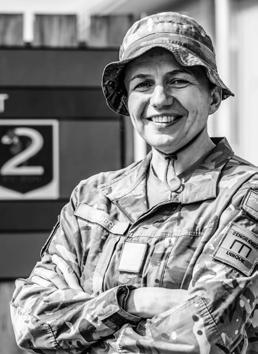
The decision has been taken to cease hibernation of the ACA and abandon it as a communications solution for the ResF. ACA(R)’s team are pursuing other options. Meanwhile, ResF units will continue to use social media applications for engagement and information flow pending a ResF-wide solution. In addition, the “RR ALL” email address and bulk emails to the SBR will continue to be used to disseminate pertinent information to our Reservists.
Send queries to WO1 Sincock, ResF SM (Army) at timothy.sincock@nzdf.mil.nz
By SGT Caroline Williams
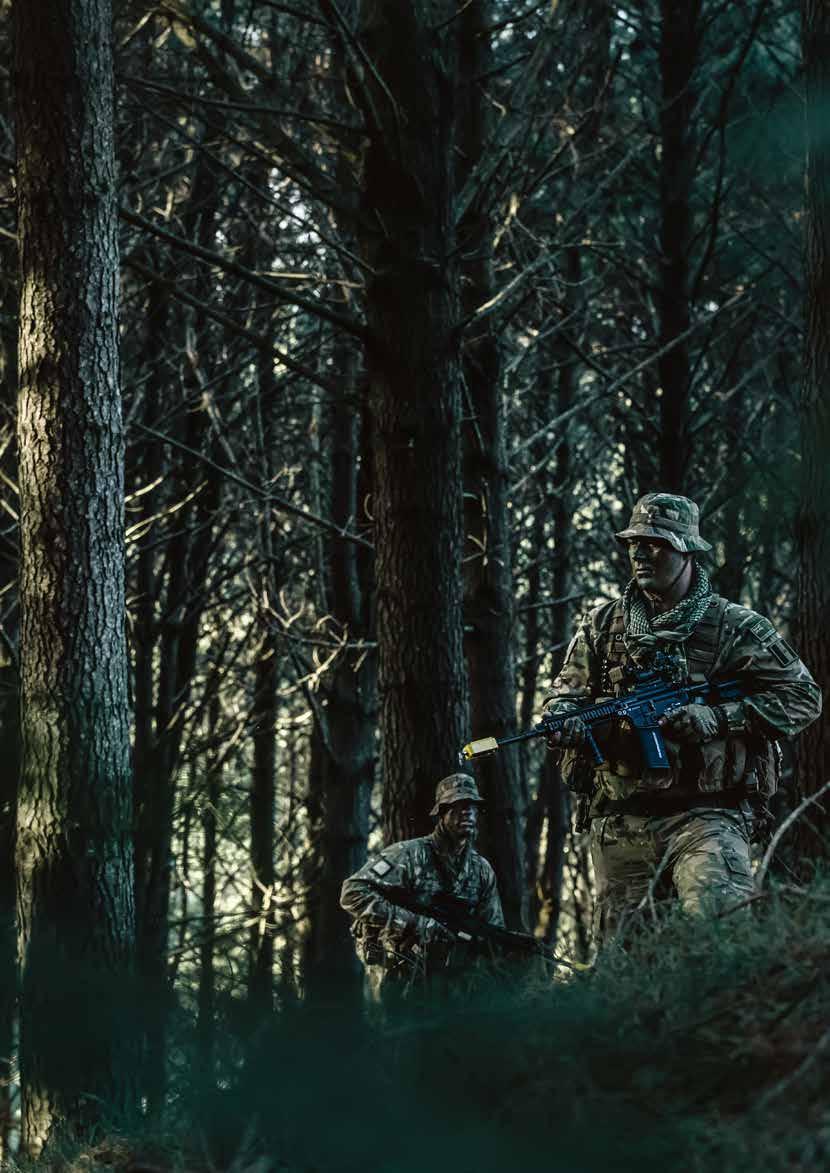
I’ve served in the Army Reserve Force for over fifteen years and have found many aspects of my Army training have crossed over into my civilian roles.
– CPL Tim McLeod
Employed as the Precision Agriculture Specialist for Brandt Tractor in Whangarei (a recent move from Milwaukee Tools) Corporal Tim McLeod combines his Reserve Force skillsets and his extensive farming knowledge to help educate clients on new technologies in one of the largest John Deere dealerships in New Zealand.
“The area I am employed in is a recently developed branch of the business, and my position is the first of its kind with Brandt. I’ve served in the Army Reserve Force for over fifteen years and have found many aspects of my Army training have crossed over into my civilian roles,” says Corporal McLeod.
He’s always recognised the importance of serving and had always wanted to join the Army. A rural farming kid, Corporal McLeod grew up on sheep and beef stations throughout the North Island. Finishing school he decided to join the Army Regular Force but having to leave for personal reasons he ticked the box to join the Reserve Force.
“I have never regretted joining the Reserve Force, I just love it. The combination of the people and the uniqueness of the job compared to anything in the civilian sector is hard to beat. It’s hard to describe to people the experiences and the reasons for staying. Actually, I met my best mates here, I wouldn’t have met them if I hadn’t joined.”
Being in the Reserve Force means he’ll need to complete at least 20 days a year in uniform which includes weekend monthly training with his unit at 3/6 Battalion, Royal New Zealand Infantry Regiment, where he serves in the role of Platoon Sergeant for 1 Platoon, Northland Company, and sometimes requires time away from work to complete leadership training or an exercise.
Last year Corporal McLeod completed his Platoon Commanders course in Waiouru Military Training Area, a physically and mentally intensive sixteen days of training. He learnt how to analyse a complex problem in a short time frame, provide a solution, confidently brief this to his superiors and then present that solution to his soldiers through the delivery of orders. He then needed to follow through on the ground with a platoon patrol, where situation changes were thrown in, forcing students to think on their feet and come up with a new course of action. Corporal McLeod has learnt, through his Army Reserve Force training, to quickly absorb, retain then utilise information immediately.
“I recently took part in a combined New Zealand and Australian Reserve Force exercise, one of the largest in many years, and utilised my training from the course. It was awesome and extremely beneficial. The exercise enabled us to be in an operational setting for a long period of time with added assets like the NZ Light Armoured Vehicles (NZ LAV) and NH-90 helicopter. The tempo was much the same that would be required during operations, and there was a lot of thinking on my feet with scenarios constantly changing on the ground.”

Corporal McLeod has a busy lifestyle but his wife is supportive and understands his desire to serve. With a full time job and two young children, he says fitting fitness into his lifestyle can be a challenge at times but he has a good base fitness through regular training, and uses his time management skills to take opportunities to train as they arise.
“Army Reserve Force training gives you a strong mindset in determination which definitely helps keep you active and focused.”
He enjoys the diversity of training and also meeting people from all walks of life throughout Aotearoa including builders, lawyers, stay-at-home parents, police, paramedics and the list goes on.
“The Reserve Force has given me a range of amazing experiences, I’ve travelled both within New Zealand and overseas, and was also selected for the Army Combat Shooting Team in 2016.
As a young infantryman I was shooting every day for three months, what’s not to like about that,” he says with a grin.
NZ Army nursing officer
Major Buffy Little is based at Base Auckland and was part of the NZDF team that flew Kiwis home from riot-torn New Caledonia in May.

“I was the nursing officer for the aeromedical evacuation team. We stood up a team of three personnel, so we had one doctor, a medic and myself. We left our medic in-country in New Caledonia, so she was able to provide patient screening prior to the evacuees jumping on the flight to make sure they were fit-to-fly. She was also able to provide some primary healthcare support to our contingent that remained in New Caledonia.
“The first flight was interesting because we didn’t really know how it was going to roll, did we have a building we were going to be able to use to do our evacuation clearances, or was it going to happen on the tarmac, and how long we had on the ground. It was a mystery for that first mission. When we landed, as we offloaded the aircraft the French brought all the evacuees out onto the tarmac in two trucks.
“We set up our stations where we screened passengers and did all the paperwork and Ministry of Foreign Affairs and Trade clearances. Part of that was the fitness-to-fly clearances and we did all that on the tarmac as they walked out to the aircraft. We gave them a medical screening form around illnesses, any alarm around flying, or any medical concerns, so we could do an assessment around whether they were fit to fly, or if they needed any ongoing support or care during the flight and once we returned to New Zealand.
“The first flight was a high risk flight, so they tried to get those with more serious medical concerns on that flight. We had one passenger who was quite unwell and required some care on the way home. The other flights went more smoothly and health issues were screened by our medic early on so medical requirements were able to be arranged ahead of time.
“It was different to the repatriation flights from Afghanistan where we were going into a war-torn country – for this one we were going to a South Pacific country with good medical facilities. So that made it easier.
The passengers were, for the most part, tourists who had pretty good health and wellbeing. We had three babies, who generally wouldn’t be allowed to fly in a Hercules, but due to the circumstances, they were given flying clearance. We needed to make sure they were okay with the altitude changes and helping equalise the pressure on their ears. So we worked with parents to help them make sure their child was as comfortable as possible. It was quite surreal though, because not only were there French soldiers around, because we were just flying in and out of the airport, we didn’t really see anything of what was happening in the country – it was surreal knowing how much turmoil there was going on, but we weren’t really seeing it. The only thing we could see was across the road from the airport was a car yard that had been burnt to the ground. That reminded us what was going on outside the secure airfield that we were in.
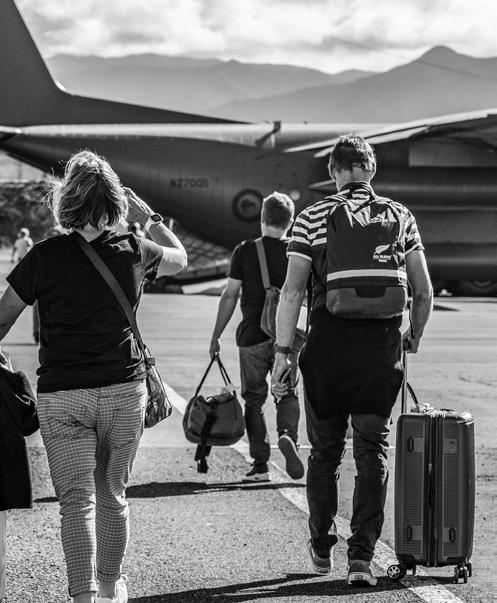
We were told to be prepared that we could encounter some upset and frustrated people because it had taken us so long to get there. But I didn’t come across anyone like that, everyone was so stoked to see us, just so pleased to be getting home. They were happy to everything we asked because they just wanted to get home – to the point where the passengers would break out in applause when we landed in Auckland. We don’t really get that on a military flight. There were also a lot of hugs for us.
It’s what we train for and to be able to do the job we train for and to see how appreciative the people who we were supporting were, makes our job even more worthwhile, and that’s what we’re here for.”
The first flight was a high risk flight, so they tried to get those with more serious medical concerns on that flight.
– MAJ Buffy Little
By MAJ (Dr) Jacques Rousseau OIC HPC
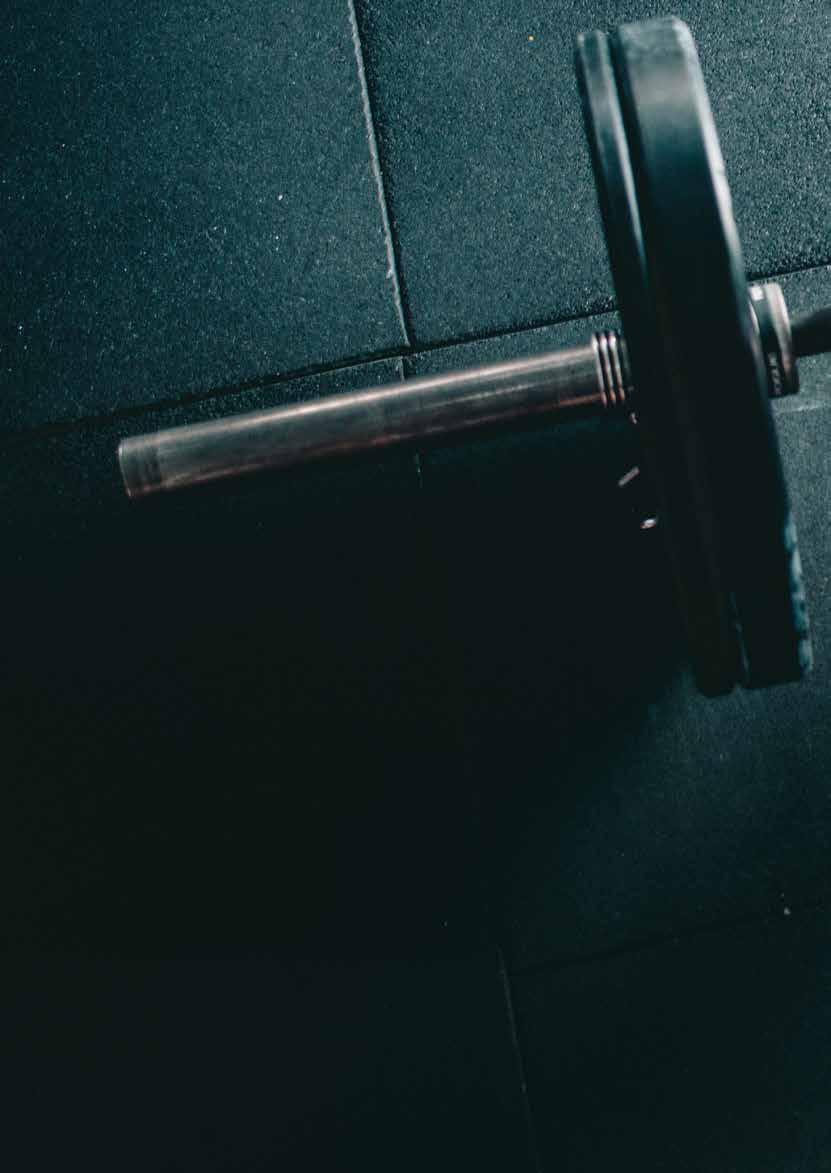
Past articles have discussed the effects and benefits of physical training. In this month’s edition we discuss cognitive fitness, the capacity to think, learn, and remember effectively, which is of paramount importance to military personnel.
In the high-stakes environment of military operations, the ability to process information swiftly and accurately can be the difference between success and failure, life and death. Cognitive fitness encompasses various mental attributes such as attention, memory, reasoning, and problem-solving skills, all of which are crucial for mission planning, situational awareness, and decision-making under pressure.
Exercise and cognitive training make a great team. Studies show that physical activity boosts various cognitive abilities, like memory and attention, especially in older adults. When you combine physical and mental challenges, the benefits seem to multiply. For example, an agility training programme improved memory and focus more than just running alone. Even activities that blend physical and mental demands, like gaming while exercising, can have a bigger impact on cognitive performance than either alone.
Being cognitively fit refers to your ability to use your brain power, knowledge, and skills to handle work tasks. It’s multi-faceted and can be improved by participating in regular cognitive gym sessions. The cognitive gym concept is based on the principle that you boost your cognitive fitness through practice and cognitive training programmes, like physical conditioning. For example, a training programme for soldiers focuses on core mental abilities and skills, using a planned approach and enjoyable assessments to monitor progress. Cognitive training uses exercises to improve skills like attention, memory, and problem-solving, tapping into the brain’s ability to adapt and learn faster and more efficiently.
In the military context, cognitive gyms are integrated into physical training programmes to ensure that personnel are mentally prepared for the demands of their roles. These include:
Task related scenarios:
Realistic simulations that mimic combat scenarios to improve decision-making skills and situational awareness.
Team-Based Cognitive Training: Exercises that enhance communication, coordination, and collective problemsolving abilities within teams.
Continuous Assessment and Feedback: Regular evaluations to monitor cognitive progress and adjust training programmes accordingly.
Exciting news is that the Human Performance Cell is currently working with the Australian Defence Science and Technology Group, Monash University and Mr Ken Franks (SME Cognitive Conditioning) in developing a military constructed cognitive gym. There is a substantial amount of interest from the 5EYES nations in this work and if all goes according to plan, the NZDF will be the 1st Military to implement a scientifically evidence based cognitive gym training programme.
By Dario Nustrini
Published by Harper Collins

Book reviews by Jeremy Seed
With the publication of this memoir, Nustrini joins a small but select group of folk who have mined their military service for humour and produced a very amusing, but also very relatable read.
Nustrini joined the RF in 2011 and on completion of 16 weeks basic (10 weeks in my day, a mate of similar vintage and I both shuddered at the thought of 16 weeks!), graduated as an EW Op, RNZ Sigs. He is very up front about the fact that due to security, there is a lot he can’t, and therefore doesn’t talk about, but you get a feel for what it involved. He also notes he changed a lot of the names….but people who feature, should be able to identify themselves.
The author’s grandfather had completed military service in the UK, and before he departed for Waiouru, Nustrini was advised by him to keep his head down and be the grey man. Hilariously within minutes of arriving, Nustrini discards this wise advice and decides that he needs to let the staff know that he has spent time in Cadets and therefore is on the inside track. When he calls a BDR, “Cpl”, the response is instant and timeless…. Nustrini realises, too late, that perhaps grandad had been onto something!
Structurally, this book was not dissimilar to the movie Full Metal Jacket, in that the first part is about basic training and the second life in a unit and on deployment to Iraq. Nustrini writes well, the book is engaging from the very beginning and anyone who has been through RF basic training in the last 40 years or so will recognise the language, the characters and the situations which arise. Nustrini matures during his service and asks very legitimate questions about the value of his service and the allied presence in Iraq….spoiler alert: not being able to get decent answers to any of his questions, Nustrini put in his 717 on RTNZ.
In many respects, it is a story as old as time. Slightly lost young men and women join the military, get stripped down as individuals and rebuilt in the image the service wants. They get access to weapons, technology, booze and friends for life, chaos ensues as do humorous adventures. I think it’s fair to say that everyone who has worn a uniform and entered the service as young and a bit directionless has probably had similar adventures and certainly has the yarns to prove it.
ANYONE contemplating a service career and wondering what it is all really about needs to read Nothing Significant to Report.
By Laura Jarvis

Early morning kicked off the
run by
have a roughly 6km circuit in which they have an hour to complete, before they have to repeat the circuit again– every hour, on the hour– until failure.
The race was all about how far you could go. The first thing to go will always be your mind, it was all about mental resilience.
– SSGT Brent Clearwater
Burnham’s inaugural Backyard Ultra was a true test of mental resilience as 89 participants started the race, completing a 6.7km lap every 60 minutes, repeating until just one runner remained.
Physical training instructor Todd Andrews, who organized the event, said he believed the Backyard Ultra would push New Zealand Defence Force personnel past there known limits, with mental endurance stretched to the limit as they fought through physical pain to race for as long as they could.
SSGT Geoffrey Smith took out the individual title, crossing the finish line for the last time 19 hours after he started, having run 127.3 kilometres. Teams were also allowed to compete, running alternating laps, with SSGT Samuel Shutkowski and LCPL Jesse Bennett completing 19 laps together.
LT Mikayla Bigwood was the winning female, completing 12 laps. This wasn’t SSGT Smith’s first race having competed in Christchurch twice before, reaching 15 and 13 laps respectively.
“What kept me going this time was the support from people around me and watching other people succeed; we all just wanted to see people keep going,” said SSGT Smith.
He also credited the set- up of his base, having everything he needed which including plenty of carbohydrates, a jar of gherkins, Gurney Goo and a foam roller.
“The set -up is critical, you only have a short amount of time to get yourself ready for the next lap.”
With 29 years in service, he was able to lean on his military training, both mental and physical.
“Over the years whether on exercise locally or deployment overseas, you are taken away from the luxuries of life. It builds up your resilience and your ability to stay strong.
“Along with the ability to train, also means we have a good level of fitness. I have been using the Zone 2 Training method and it has really made a difference.”
This is the first time a backyard ultra has been held at Burnham and PTI SSGT Brent Clearwater said it is the perfect test for soldiers.
“The race was all about how far you could go. The first thing to go will always be your mind, it was all about mental resilience,” SSGT Clearwater said.
“The course was very flat, so you had to pace yourself and run at a speed which you could keep up for hours on end – which was a lot slower than people would naturally want to go.”
Current New Zealand champion Sam Harvey, whose record is set at 101 laps, was there at the starting line to pass on some advice.
“It important to break it down into little chunks and don’t let it be anything bigger than it really is. If you focus on the scale of the endeavor that you have ahead of you, that’s when you get into your own head.”
“Generally the best people in ultra or backyard marathon there not the youngest or the fastest but the ones that have been through a few hardships or challenges and then are able to use that to dig deep.”


Whether you like painting, sculpting, photography or are someone who has always wanted to give art a try, we encourage all skill levels to take part. It is open to any current serving or ex-serving NZDF injured, wounded or ill personnel, their family and friends and Families of the Fallen.
Submissions Close: 9 August 2024
Selected artworks will go on display in the Pumanawa Art Gallery in Christchurch from 1–6 October 2024.
To register or for more information, please email artinrecovery@nzdf.mil.nz.

Trooper Levani Rova, a member of the NZDF sevens rugby team visited his former high school, Mt St Marys during the team’s recent visit to Fiji. The team ran skills clinics at local high schools in Nadi, and distributed balls to some of the schools.
“We taught the kids some basic skills. I felt quite nostalgic when I visited my old school Mt St Marys. It was good to be able to give them a ball – when I was there we played with old plastic bottles or coconut shells.”
The team played the Fijian Army, and lost 24–17. “It was a very physical game and was a bit hard to mount a significant defence.” Based at QAMR in Linton TPR Rova has been in New Zealand for 14 years.
The 2024 ADFHACC featured men’s and women’s teams from New Zealand’s three services and ADF combined service state teams. It was hosted at the Shoalhaven Hockey Centre in Nowra, NSW.
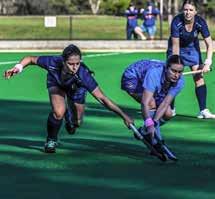
The ADFHACC tournament, showcased an array of hockey talent from both Australia and New Zealand. Both the men’s and women’s competitions were fiercely contested, culminating in a spectacular display of skill and determination. The Army men’s team won the championship and delivered an outstanding performance throughout the tournament. During the round robin stage the men placed 3rd, with 4 wins, 1 draw and 2 losses, sending them through to the semi-finals. This put them up against the 2nd placed RNZN. A physical match between the Army and Navy resulted in the Army edging out a 3-1 win. The final match up would be against the unbeaten Queensland men, and after a strong performance by the Army men’s team they took home the title beating Queensland 3–0.
The combined New Zealand Army / RNZN women’s team also had a commendable tournament, finishing in a respectable fourth place. A strong performance in the round robin stage with 3 wins and 1 loss put them 1st going into the playoffs.
A tough match up against NSW would unfortunately see the women losing 3–2 and putting them up against the RNZAF in the 3rd place playoff. A closely contested game would see the combined drawing 0–0 and narrowly losing on shoot outs 3–2, securing fourth place for the tournament. Standout performers throughout the tournament included LCPL Reed taking out the women’s top goal scorer award with 4 goals, and PTE Schnauer taking out the men’s top goal scorer award with 15 goals.
Following the conclusion of the tournament, players from both the men’s and women’s teams were selected for the NZDF team to play the ADF on Anzac Day. From the men’s team, seven players were selected and four players from the women’s. The Anzac Day matches saw a tough women’s clash with the ADF women coming out on top in a 3–1 win. Scorer for the NZDF was LCPL Blackwood. The men’s match was also a hard fought contest, with the NZDF team defeating the ADF 3-2. Goal scorers for the NZDF men were PTE Lindberg, SGT Hilbourne and LCPL Collins.
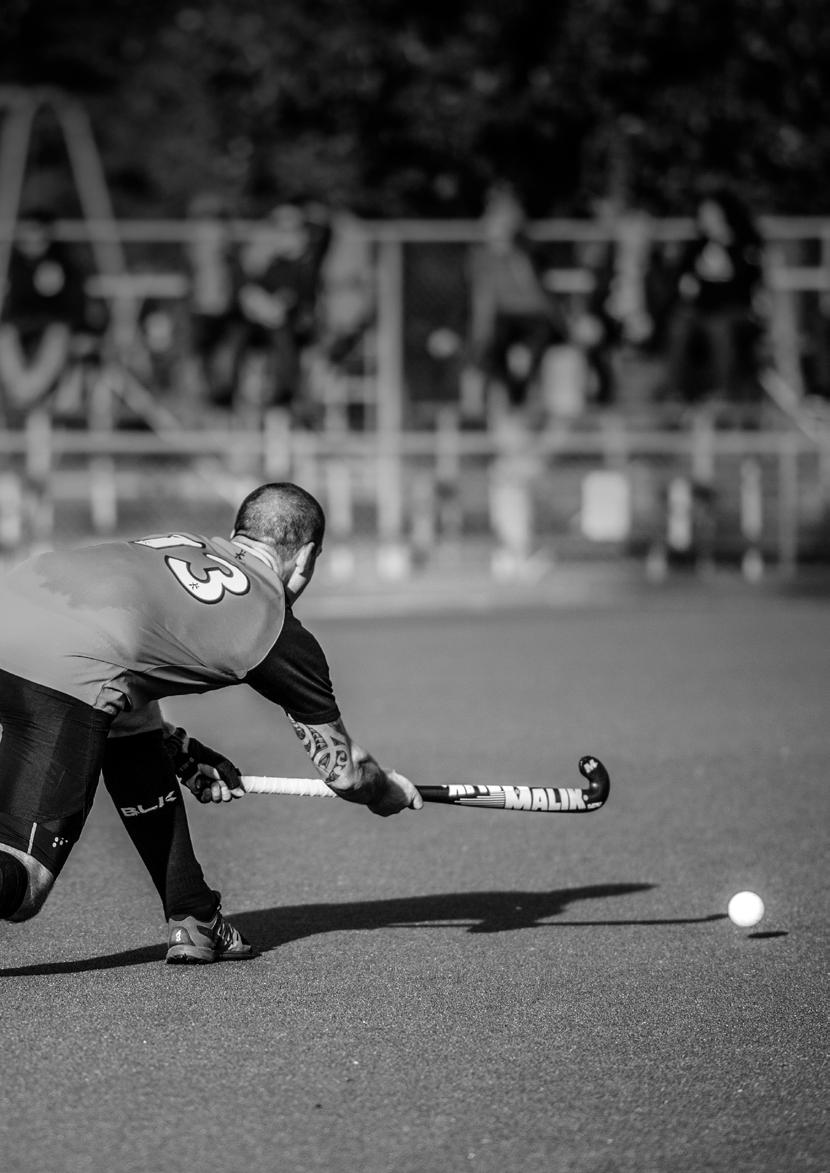
Exercise Active Edge 2 was a 2 CSSB logistics training exercise that took place in the Waiouru Military Training Area providing support and assistance to Exercise Brimstone and Exercise Vengeance. The exercise evaluated the Combat Service Support team in the ability to plan and execute small team tasks to deliver a logistics function.
